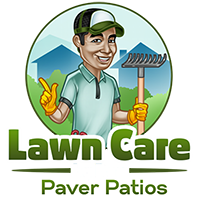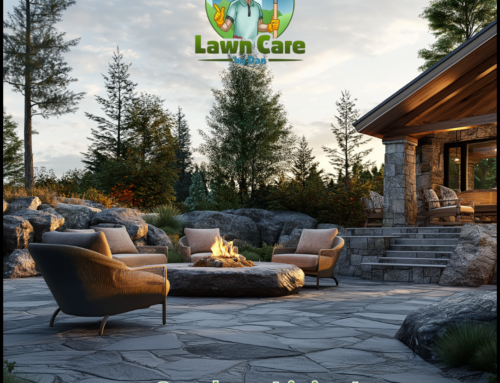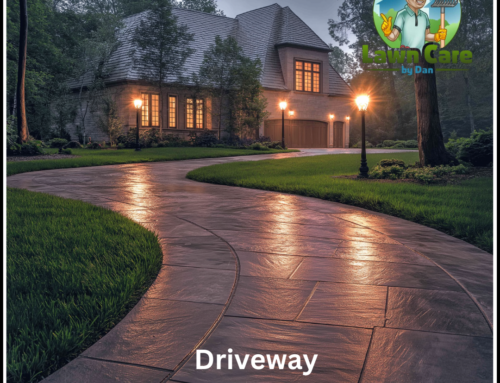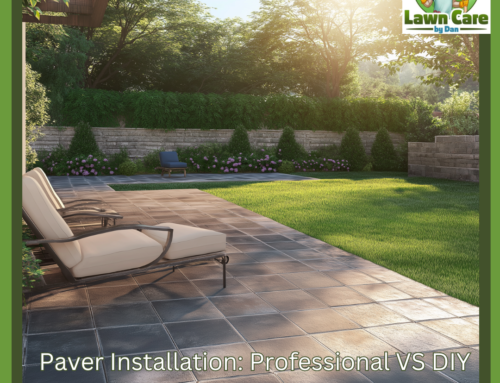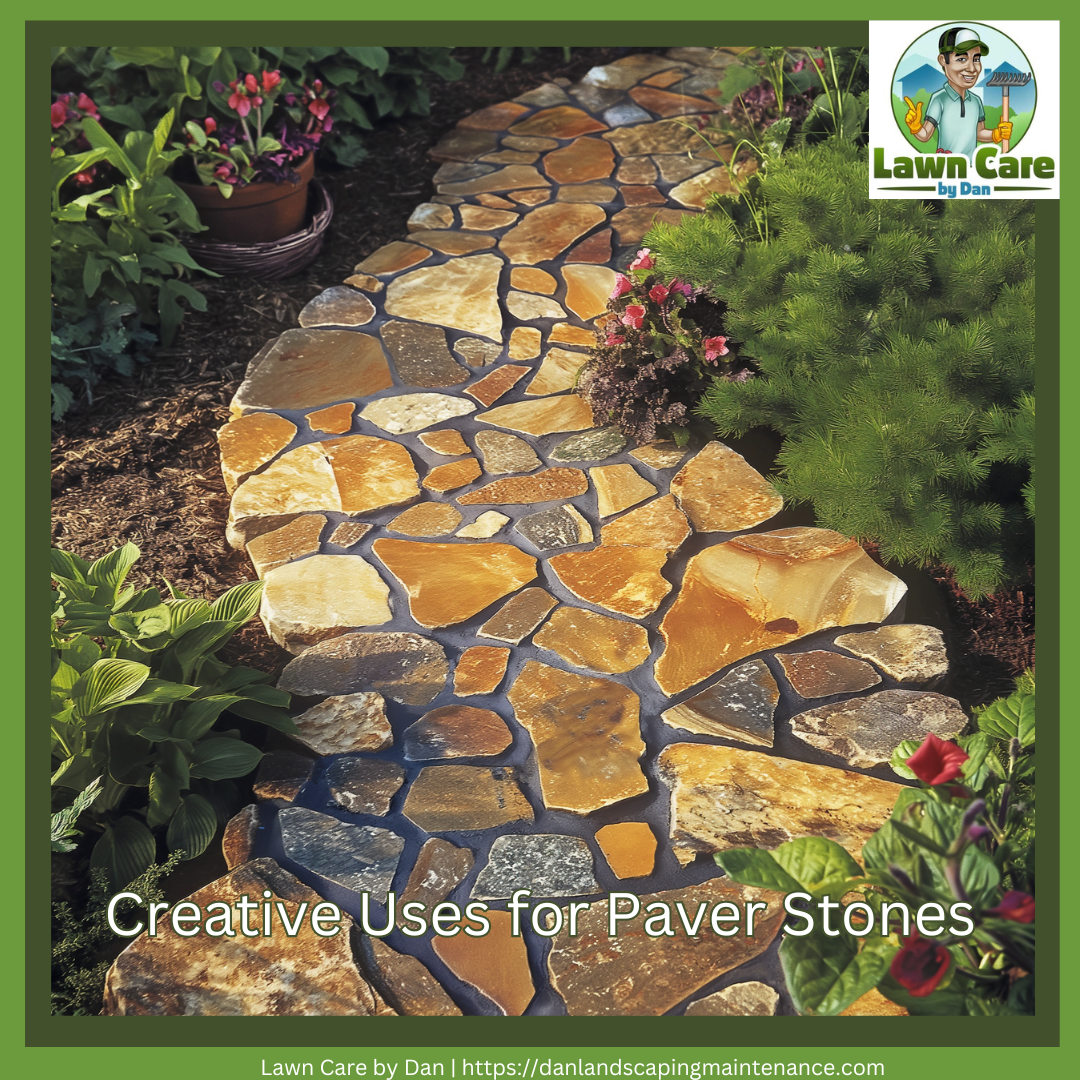
Imagine transforming your outdoor space into a breathtaking sanctuary where every step gives you peace and tranquility. At Lawn Care By Dan Paver Patios, we believe the secret to an extraordinary outdoor area lies in the details. Paver patterns can elevate any yard, turning it from ordinary to extraordinary with the right design and placement.
This is part 2 of this article.
7.
Checkerboard Paver Patterns
The checkerboard design is a classic, timeless pattern that adds a playful yet sophisticated touch to any outdoor space. This pattern is created by alternating pavers of different colors or materials in a grid-like fashion, resembling a checkerboard. It’s a versatile design that can enhance various areas, from patios and driveways to garden paths and courtyards.
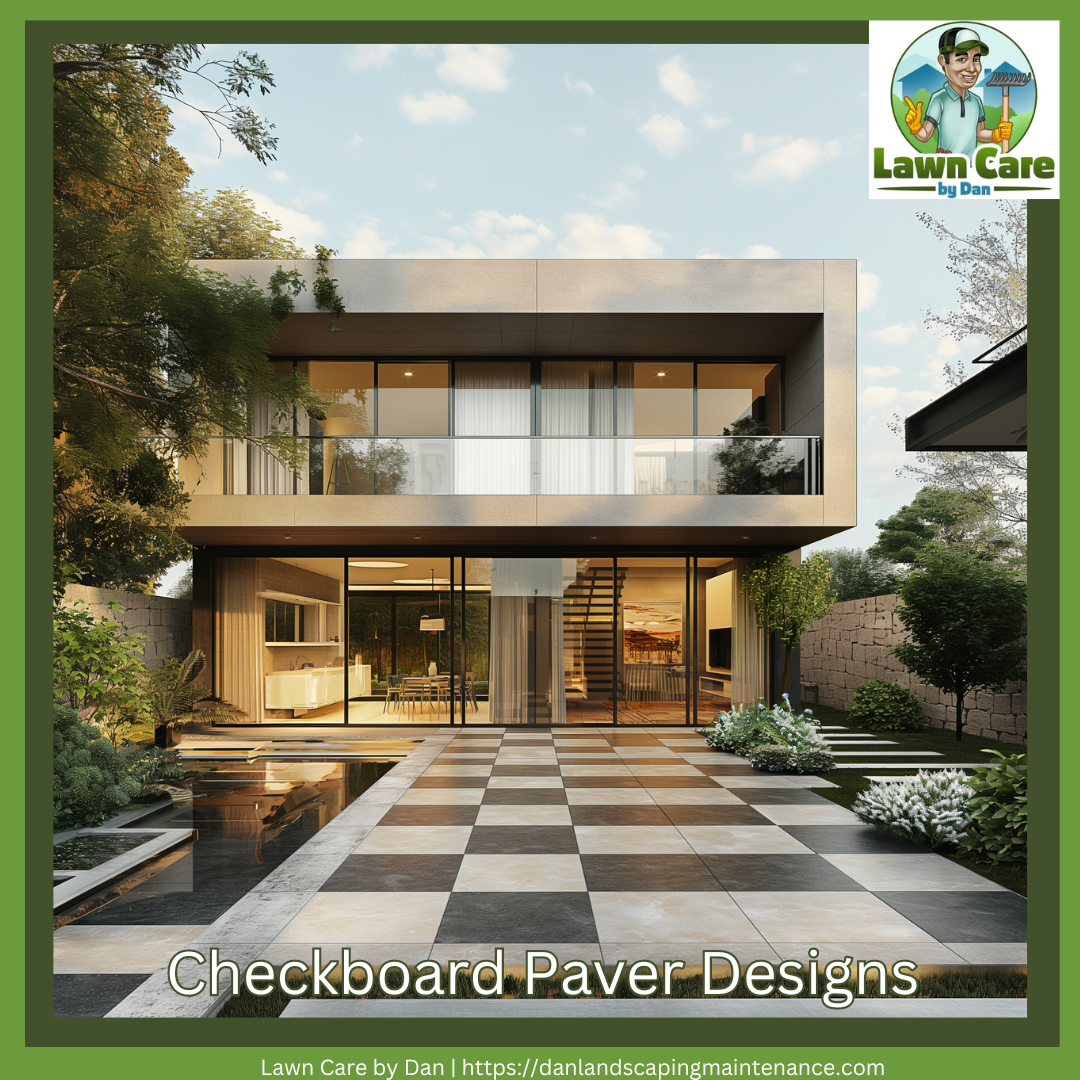
Practical Applications
The checkerboard design can be used in various outdoor spaces, adding beauty and functionality. Here are some practical applications:
- Patios: A checkerboard pattern creates an inviting and stylish patio area. The contrasting colors provide a playful yet elegant backdrop for outdoor furniture and entertaining spaces.
- Walkways: Enhance your garden or front yard with checkerboard-patterned walkways. The pattern adds visual interest and guides visitors through your landscape.
- Driveways: A checkerboard paver driveway can add curb appeal to your home. The bold design complements various architectural styles and makes a memorable first impression.
- Courtyards: The checkerboard pattern transforms courtyards into charming and aesthetically pleasing areas, adding a sense of order and sophistication to the space.
- Pool Decks: Use the checkerboard pattern around your pool for a stylish, slip-resistant surface. The design can enhance the overall look of your pool area and create a cohesive outdoor space.
Design Tips
- Color and Material Choice: Select contrasting colors or materials that complement your home’s exterior and landscape. Popular choices include black and white, red and grey, or natural stone and concrete. Ensure the colors are distinct enough to create the desired checkerboard effect.
- Size and Proportion: Consider the pavers’ size and the area’s overall scale. Larger pavers can make a bold statement, while smaller pavers can create a more intricate and detailed pattern.
- Bordering and Accents: To frame the checkerboard pattern, add borders or accent pavers. This can enhance the design and create a defined edge for the paved area. Using a different color or material for the border can make the pattern stand out even more.
- Lighting: Incorporate outdoor lighting along the edges of the checkerboard pattern to highlight its beauty at night. Path lights, spotlights, or LED strips can enhance the visual appeal and improve safety.
- Integration with Other Patterns: Consider combining the checkerboard design with other patterns for a more complex look. For example, you can use a checkerboard for the main area and a herringbone or linear pattern for borders or accents.
Did you know…
Historically, the checkerboard pattern has been used in royal and noble residences across Europe. This pattern was often associated with grandeur and sophistication, adding an element of prestige to the estates.
8.
Randomized Natural Stone Paver Patterns
The randomized natural stone pattern mimics the look of natural stone paving for a more organic and rustic feel. This design creates a relaxed and informal atmosphere in gardens and around pools. The varied shapes and sizes of the pavers contribute to a natural and effortless look.
Practical Applications
The randomized natural stone look can be incorporated into various outdoor spaces, adding both beauty and functionality. Here are some practical applications:
- Patios: A randomized natural stone pattern creates a charming and inviting patio area. The natural look provides a stylish and comfortable backdrop for outdoor furniture and entertaining spaces.
- Walkways: Enhance your garden or front yard with natural stone walkways. The irregular shapes and varied colors add visual interest and guide visitors through your landscape.
- Driveways: Add curb appeal to your home with a natural stone driveway. The unique design can complement various architectural styles and make a memorable first impression.
- Garden Paths: Use natural stone pavers to create enchanting garden paths. Their organic appearance blends seamlessly with the natural surroundings, making exploring the garden more enjoyable.
- Pool Decks: Incorporate natural stone patterns around your pool for a sophisticated, slip-resistant surface. The design can enhance the overall look of your pool area and create a cohesive outdoor space.
Design Tips
- Color and Texture: Use various colors and textures to create depth and interest in your natural stone pattern. Combining different types of stones can add complexity and richness to the design.
- Size and Proportion: Consider the size and proportion of the stones with the space. Larger stones can create a more dominant look, while smaller stones can add intricate detail.
- Symmetry and Balance: While the design is randomized, ensure balance and harmony in the overall layout. This creates a cohesive look and prevents the design from feeling chaotic.
- Focal Points: Use natural stone patterns to create focal points in your outdoor space. This can be a central design in a patio, a highlighted area in a walkway, or an accent feature in the garden.
- Lighting: Enhance the beauty of your natural stone pattern with strategic lighting. Use path lights, spotlights, or LED strips to highlight the design at night, enhancing its visual appeal and improving safety.
Did you know…
The use of natural stone in landscaping dates back thousands of years. Ancient civilizations, including the Egyptians and Romans, used natural stone for their majestic gardens and courtyards, a testament to its timeless beauty and durability.
9.
Flowing Wave Paver Patterns
Wave patterns can bring a sense of movement and fluidity to your outdoor space. These designs are ideal for pathways and garden edges, guiding the eye and creating a sense of flow. Depending on the contrast and curvature of the pavers used, wave patterns can be subtle or bold.

Practical Applications
Flowing wave patterns can be incorporated into various outdoor spaces, adding both beauty and functionality. Here are some practical applications:
- Pathways: Create enchanting pathways with flowing wave patterns that guide visitors through your garden or yard. The dynamic curves add a sense of movement and intrigue, making the journey more enjoyable.
- Patios: Enhance your patio area with a flowing wave design. The pattern provides a stylish and comfortable backdrop for outdoor furniture and entertaining spaces.
- Driveways: A wave-patterned driveway can add curb appeal to your home. The unique design complements modern architectural styles and makes a memorable first impression.
- Pool Decks: Incorporate wave patterns around your pool for a sophisticated, slip-resistant surface. The flowing design can enhance the overall look of your pool area and create a cohesive outdoor space.
- Garden Borders: Use wave patterns to define garden borders and edges. The curves add a whimsical touch and can help separate different areas of your landscape.
Design Tips
- Color and Texture: Use various colors and textures to create depth and interest in your wave pattern. Combining different types of pavers can add complexity and richness to the design.
- Contrast and Complement: Consider using contrasting colors to highlight the curves of the wave pattern. Alternatively, use complementary colors for a more subtle and harmonious effect.
- Size and Scale: Adjust the size and scale of the waves to fit the space. Larger waves can make a bold statement, while smaller waves can add intricate detail.
- Lighting: Enhance the beauty of your wave pattern with strategic lighting. Use path lights, spotlights, or LED strips to highlight the curves at night, enhancing its visual appeal and improving safety.
- Integration with Natural Elements: Combine wave patterns with natural elements like plants, rocks, or water features to create a harmonious and balanced design. This integration can soften the geometric lines and add a natural touch to your space.
Did you know…
Wave patterns have been used in art and design for centuries. One of the most famous examples is the Great Wave off Kanagawa, a woodblock print by Japanese artist Hokusai, which captures the beauty and power of the ocean’s waves.
10.
Garden Path Stepping Stones
Stepping stones can create charming garden paths that wind through your landscape. Using pavers of different shapes, sizes, and materials, you can craft a whimsical trail that encourages exploration. This design is perfect for adding a personal touch to your garden.
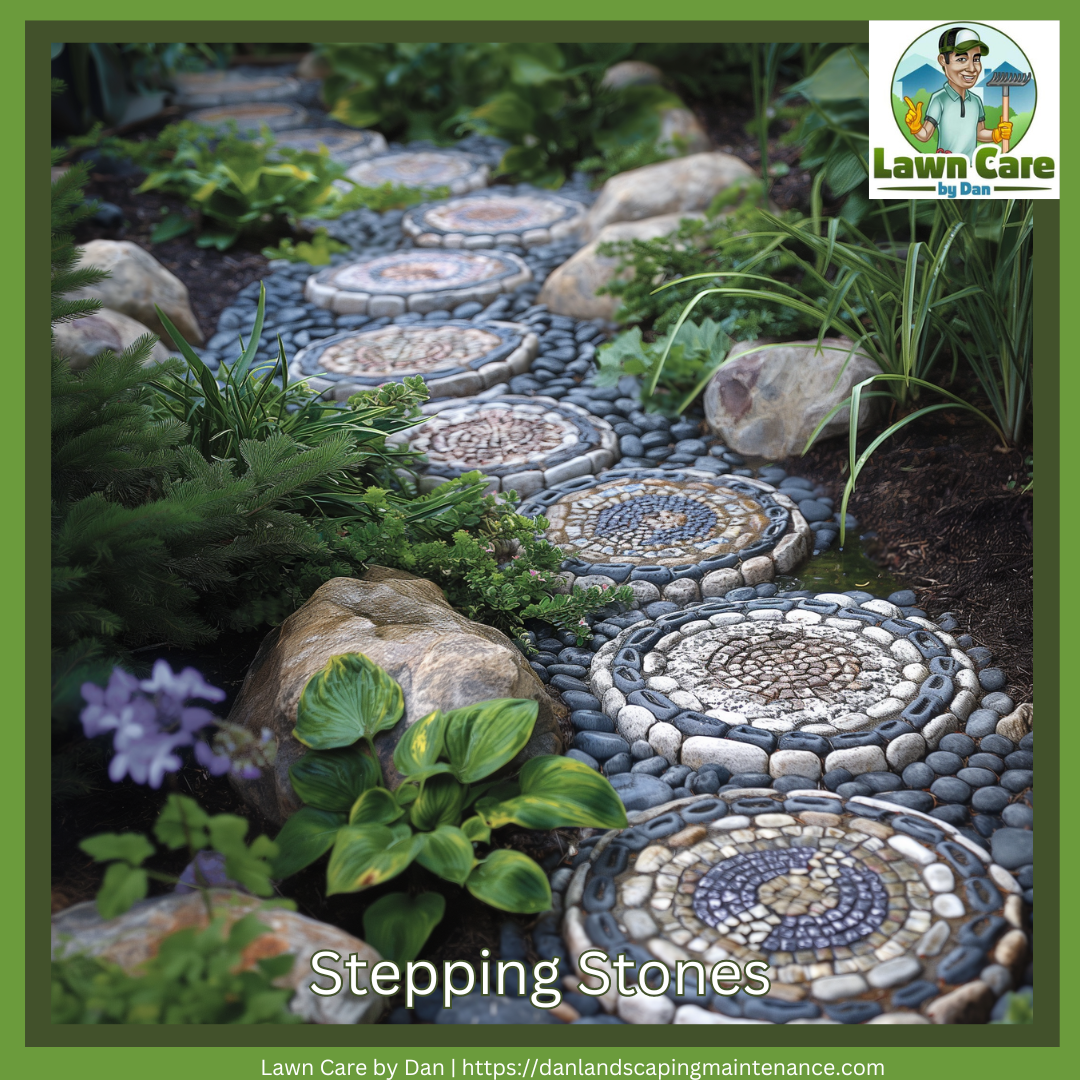
Practical Applications
Garden path stepping stones can be used in various outdoor spaces, adding both beauty and functionality. Here are some practical applications:
- Connecting Garden Areas: Use stepping stones to create a path that connects different areas of your garden, such as flower beds, vegetable plots, and seating areas. This makes it easier to navigate and enjoy your garden.
- Leading to Features: Guide visitors to key features in your garden, such as a fountain, gazebo, or pond, with a charming stepping stone path. The path can enhance the overall design and highlight these focal points.
- Enhancing Lawns: Create pathways through your lawn to reduce wear and tear on the grass. Stepping stones provide a practical solution for frequently traveled areas, helping to maintain a lush and healthy lawn.
- Accessing Raised Beds: Stepping stones can access raised garden beds, making it easier to tend to plants without compacting the soil. They also add a decorative element to the garden.
- Patio and Deck Paths: Use stepping stones to connect patios, decks, and outdoor living spaces with the rest of your garden. The stones can create a seamless transition between different areas of your landscape.
Design Tips
- Material Choice: Select stepping stones that complement your garden’s style and color scheme. Natural stone offers a timeless and organic look, while concrete and brick can provide a more contemporary feel.
- Shape and Size: Vary the shapes and sizes of the stepping stones to create a more natural and interesting path. Irregular shapes can add a rustic charm, while uniform shapes provide a more polished appearance.
- Plant Integration: Incorporate low-growing ground cover plants, such as thyme or moss, between the stepping stones to soften the edges and add greenery. This can enhance the natural look of the path.
- Lighting: Install pathway lights along the stepping stone path to illuminate the way at night. Solar-powered lights are an eco-friendly option that can enhance the safety and beauty of the path.
- Texture and Grip: Choose stepping stones with a textured surface to provide better grip, especially in wet conditions. This can help prevent slipping and ensure the path is safe to walk on.
Did you know…
The concept of stepping stones dates back to ancient Japan. In Japanese gardens, stepping stones, known as “tobi-ishi,” were used to guide visitors through the garden and encourage a mindful, contemplative journey. These stones were often placed irregularly to slow down the pace and allow for reflection
11.
Geometric Grid Paver Patterns
Geometric grid patterns bring any outdoor space a clean, modern, and organized aesthetic. These patterns use straight lines and right angles to create a sense of order and symmetry, making them ideal for contemporary landscapes and architectural styles. The geometric grid can be a practical solution for various applications, from patios and pathways to driveways and courtyards, offering functionality and visual appeal.
Practical Applications
Geometric grid patterns can be used in various outdoor spaces, adding both beauty and functionality. Here are some practical applications:
- Patios: Create a sleek, contemporary patio area with a geometric grid pattern. The clean lines provide a stylish backdrop for outdoor furniture and entertaining spaces.
- Walkways: Enhance your garden or front yard with grid-patterned walkways. The organized layout guides visitors through your landscape, creating a sense of order and direction.
- Driveways: A geometric grid driveway adds curb appeal to your home. The modern design complements contemporary architectural styles and makes a memorable first impression.
- Courtyards: Grid paver designs transform courtyards into stylish and functional areas. The pattern adds a modern touch and can be combined with other elements like greenery and lighting for a complete look.
- Pool Decks: Use grid patterns around your pool for a sophisticated, slip-resistant surface. The design can enhance the overall look of your pool area and create a cohesive outdoor space.
Design Tips
- Color and Texture: Experiment with different colors and textures to create a unique look. Using contrasting colors can highlight the pattern, while similar tones can create a more subtle effect. Smooth or textured pavers can add depth and interest.
- Size and Proportion: Consider the pavers’ size and the area’s overall scale. Larger pavers can create a bold statement, while smaller pavers can add intricate detail. Ensure the proportions are balanced to maintain the grid’s visual appeal.
- Accent Lines: Incorporate accent lines using different colors or materials to add visual interest. These can break up the monotony of a single color and create a more dynamic design. For example, you could use a different color for every fourth or fifth row.
- Lighting: Strategic lighting can enhance the beauty of your grid pattern. At night, use path lights, spotlights, or LED strips to highlight the design, enhancing its visual appeal and improving safety. In-ground lights along the grid lines can create a stunning effect.
- Integration with Other Patterns: Consider combining the geometric grid with other patterns for a more complex look. For example, you can use grid patterns for the main area and a herringbone or basket weave pattern for borders or accents.
Did you know…
Geometric patterns have been used in art and architecture for thousands of years. Ancient civilizations like the Greeks and Egyptians used grid-based designs in their mosaics, buildings, and layouts. These patterns were not only aesthetically pleasing but also symbolized order and harmony.
12.
Rustic Cobblestone Streetscape Pavers
Cobblestone patterns bring old-world charm and character to any outdoor area. This design uses rounded stones to create a textured and durable surface, perfect for driveways and walkways. The irregular shapes and sizes of the cobblestones add to the rustic appeal.
Practical Applications
Cobblestone patterns can be incorporated into various outdoor spaces, adding both beauty and functionality. Here are some practical applications:
- Driveways: Create a grand entrance with a cobblestone driveway. The durable and textured surface can withstand the weight of vehicles while adding a touch of old-world elegance to your home.
- Patios: Enhance your patio area with a cobblestone pattern. The rustic charm of the cobblestones provides a stylish and comfortable backdrop for outdoor furniture and entertaining spaces.
- Walkways: Cobblestone walkways add character to your garden or front yard. Their irregular shapes and varied sizes create a natural and inviting path that guides visitors through your landscape.
- Courtyards: Transform courtyards into charming and aesthetically pleasing areas with cobblestone patterns. The timeless design adds a sense of history and sophistication to the space.
- Garden Paths: Cobblestones create enchanting garden paths. Their organic appearance blends seamlessly with the natural surroundings, making exploring the garden more enjoyable.
Design Tips
- Color and Texture: Use various colors and textures to create depth and interest in your cobblestone pattern. Combining different types of stones can add complexity and richness to the design.
- Size and Proportion: Consider the size and proportion of the cobblestones to the space. Larger stones can create a more dominant look, while smaller stones can add intricate detail.
- Symmetry and Balance: While the design is randomized, ensure a sense of balance and harmony in the overall layout. This creates a cohesive look and prevents the design from feeling chaotic.
- Focal Points: Use cobblestone patterns to create focal points in your outdoor space. This can be a central design in a patio, a highlighted area in a walkway, or an accent feature in the garden.
- Lighting: Enhance the beauty of your cobblestone pattern with strategic lighting. Use path lights, spotlights, or LED strips to highlight the design at night, enhancing its visual appeal and improving safety.
Did you know…
Cobblestones have been used for centuries in Europe, dating back to the Roman Empire. The Romans were among the first to use cobblestones for their roads, creating durable and efficient pathways that connected their vast empire. This ancient technique has stood the test of time, becoming a popular choice for creating beautiful and functional outdoor spaces.
13.
Artistic Paver Insets
Artistic paver insets add a unique and personalized touch to your outdoor space. These insets can include custom-made pavers with engraved designs, colorful tiles, or even small mosaics. They serve as focal points and decorative accents, enhancing the aesthetic appeal of patios, walkways, driveways, and garden areas. Creativity and craftsmanship allow artistic paver insets to transform any outdoor space into a visual masterpiece.
Practical Applications
Artistic paver insets can be used in various outdoor spaces, adding both beauty and functionality. Here are some practical applications:
- Patios: Create a stunning patio with artistic insets as focal points. Consider incorporating a custom mosaic or engraved paver in the center of the patio or at the entrance.
- Walkways: Enhance your garden or front yard with walkways that feature artistic insets at regular intervals. These insets can guide visitors through your landscape and highlight specific areas.
- Driveways: A driveway with artistic insets can add curb appeal to your home. Consider placing custom pavers at the entrance or along the edges to create a distinctive look.
- Garden Borders: Use artistic insets to define garden borders and edges. These decorative elements can add a touch of elegance and charm to your garden, making it more visually appealing.
- Pool Decks: Incorporate artistic insets around your pool for a sophisticated, slip-resistant surface. The custom designs can enhance the overall look of your pool area and create a cohesive outdoor space.
Design Tips
- Color and Texture: Choose colors and textures that complement your overall paver design. Artistic insets should stand out while harmonizing with the surrounding pavers. Consider using vibrant colors for a bold look or subtle tones for a more understated effect.
- Shape and Size: Vary the shapes and sizes of the insets to create visual interest. Round, square, or custom-shaped insets can add uniqueness to your design. Ensure the insets are proportionate to the surrounding pavers.
- Symmetry and Balance: Maintain balance and harmony in your design. Even though insets are meant to stand out, they should not overpower the overall pattern. Symmetrical placement can help achieve a cohesive look.
- Lighting: Highlight your artistic insets with outdoor lighting. Use spotlights, path lights, or LED strips to illuminate the insets at night, enhancing their visual appeal and improving safety.
- Themes and Motifs: Consider incorporating themes or motifs that reflect your interests or the style of your home. Floral designs, geometric patterns, or family initials can add a personal touch to your outdoor space.
Did you know…
The art of inlaying stones dates back to ancient civilizations. The Greeks and Romans used intricate stone inlays in their mosaics and buildings to tell stories and showcase their craftsmanship. This ancient technique inspires modern designs, allowing homeowners to add historical and artistic elements to their landscapes.
